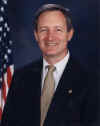
|
CONNECTIONS
|
IDAHO
ITD
HOME
IDAHO DMV
ITD NEWS
HIGHWAY
SAFETY
IDAHO STATE
POLICE
TRAVEL SERVICES
STATE OF IDAHO
NATIONAL
AASHTO
AAMVA
AAA of IDAHO
FEDERAL HIGHWAYS
FEDERAL AVIATION
IDAHO STATE POLICE
NHTSA
NTSB
TRB
U.S. DOT
Idaho
Transportation
Department
Public Affairs Office
P.O. Box 7129
Boise, ID 83707
208.334.8005
Fax: 208.334.8563
Email

A
Valley Forge Christmas
Guest column
U.S. Sen. Mike Crapo
During its long history, the American military has celebrated many wartime
Christmases. Our men and women in uniform are doing it again right now
in Iraq and Afghanistan. But, perhaps one of the most difficult Christmas
celebrations by members of the Armed Forces occurred very early on in
our history and it demonstrates the true grit and tenacity of American
troops.
 In
December of 1778, just before Christmas, the Army was retreating in
the face of a British advance. The Continental Army under George Washington
had been based in Philadelphia, where two years before the Declaration
of Independence had been signed. But when the British began to move
into the city, our Army, outgunned and outnumbered, took to the Pennsylvania
countryside to a place called Valley Forge.
In
December of 1778, just before Christmas, the Army was retreating in
the face of a British advance. The Continental Army under George Washington
had been based in Philadelphia, where two years before the Declaration
of Independence had been signed. But when the British began to move
into the city, our Army, outgunned and outnumbered, took to the Pennsylvania
countryside to a place called Valley Forge.
When Washington arrived at Valley Forge, the situation was desperate. But his overall objective that season remained the same--to keep the Army together and keep the dream of American independence alive.
While the situation seemed dire, the Army still celebrated Christmas. It snowed heavily on Christmas Day 1778 and the men, having not yet built more sturdy structures, were still in tents. They were a long way from home in very difficult conditions, but Washington did his best to see that the soldiers had some kind of Christmas. He visited as many of the men as he could on Christmas Day and saw to it that what rations were available were distributed for what passed as a festive meal.
It was also at Valley Forge that George Washington is said, to have ridden into the woods by himself to pray on Christmas Day.ß No one really knows what he prayed about, but his need to find some time to be alone and talk to God, was a mark of the very spiritual side of this rather remarkable individual. A print of this event as imagined by Arnold Friberg hangs in my Washington, D.C. office. It serves as a reminder to me of how Washington faced some of the trying times during our country’s early years.
Amazingly enough, in spite of all the adversity, the morale of the Continental Army that Christmas was surprisingly high. Even without adequate rations and in the face of appalling living conditions, the men sang, told stories, and passed a joyous, albeit somewhat meager Christmas.
Christmas in Valley Forge became a turning point for the Army. It gave them the lift in spirits that started a transformation. As the winter continued, the Continental Army went about remaking itself. Each day, even in the face of cold and hunger, men from all the different colonies trained together, worked together, undertook field exercises, and got ready for what was still a very long war ahead.
When our Army left Valley Forge in June, morale was high, and discipline and organization far better than it had been a few months before. Just ten days after breaking camp, our troops fought the British to a standstill at the Battle of Monmouth. But the real message of Valley Forge was in the spirit of our young military, at that time only three years old, and its commitment and perseverance in the face of hardship.
Although 226 years have passed since that Christmas at Valley Forge, our military, whether at home, or overseas, continues to show that same spirit of perseverance and determination that is the backbone of American independence.
I think George Washington would be very proud of them.